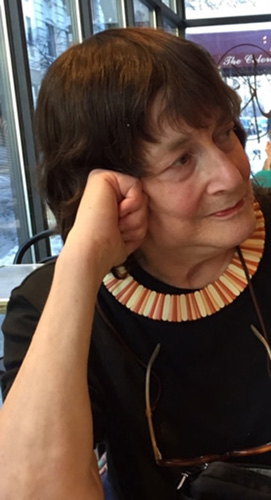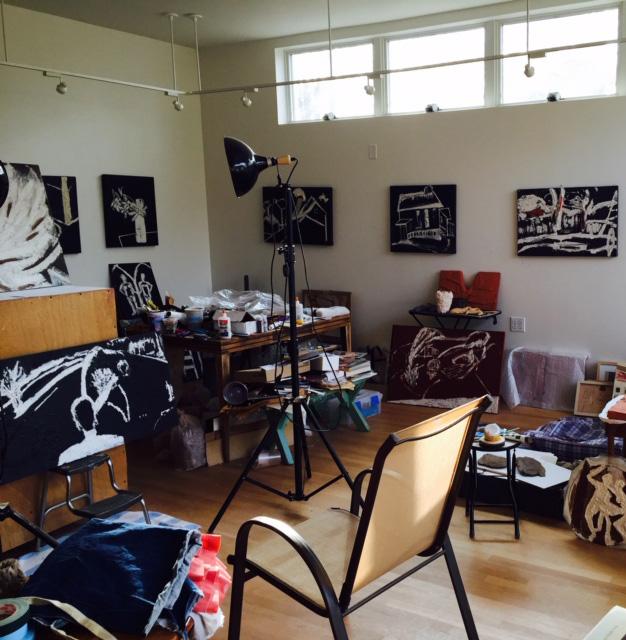
Childhood and Education
Barbara Goodstein was born in Philadelphia, Pennsylvania, on March 24, 1945. After attending local public schools in the suburb of Upper Darby, she graduated from the Pennsylvania State University in 1966. Having, in college, become a museum-goer, and having started to make sculpture, she was instrumental in having her graduating class sponsor a gift of a Calder sculpture to the university. In 1967, while working as a high-school teacher in the Philadelphia public school system. she took sculpture courses at the Tyler School of Art. In a subsequent couple of years of foreign travel (during which she lived in Israel as well), she traveled to Europe and studied at the Plymouth College of Art and Design in England in 1968-69. In 1969 while in Mexico, Goodstein attended the University of Guadalajara there. Having returned to the United States, she enrolled at the New York Studio School where, in 1971-72, she came under the influence of the painter Leland Bell and the sculptors Peter Agostini and George Spaventa. She went on to study with the painters Louis Finkelstein and Gabriel Laderman--the latter her close friend until his death--in the Queens College graduate fine-arts program, where she earned a Master of Fine Arts in sculpture in 1974. Her study with the sculptor Natalie Charkow there led to another lifelong friendship.Contexts
Throughout her life, Goodstein was interested in visual and musical rhythms, indigenous structures of many cultures ranging from maps to houses and places of worship, and many sorts of formal expression across the arts. Some study of modern dance as an undergraduate led to her lifelong passion for dance, and especially the American art forms of tap--she was an enthusiast for the Nicholas Brothers---and jazz and swing dancing: Fred Astaire was the object of an obsession. She also followed Paul Taylor’s dancing throughout his career, and in her last few years she was listening to all of Astor Piazzolla’s tango-based musical compositions. Goodstein's most readily identifiable work was relief sculpture, usually in white acrylic plaster on a wooden board painted black. This was a medium she invented. These relief sculptures were often referred to (though not by the artist) as paintings or pictures. And no doubt her drawing-as-relief sculptures reflect her studies with and ties to painters and painting. But her interests in the third dimension were broad and eclectic, spanning centuries, cultures, and styles. She was interested in tribal and ritual arts of Asia, Oceania, and Africa, and the sacred art of Western Europe. Throughout her career she thought of Cézanne, of Julio Gonzalez, Calder, Giacometti, Gabo, and other sculptors whose modernism was also hers. Imbued with these sources, Goodstein’s work in her earlier years was often centered on the human figure--the nude model in the studio, a theme she took up repeatedly in clay; invented, somewhat abstracted figures, dancing, gesticulating; and figure compositions in relief, sometimes based on paintings by Cézanne, among others. Goodstein’s curiosity about architectural structures followed naturally from living and working in cities--New York and Philadelphia--and in relief she studied the ornate decorations of the Philadelphia City Hall and the rooftops of Queens, New York. Her cityscape compositions reflect also her interest in spatial structures such as the indigenous houses of the Maori which she knew only from photographs, as well as the local and indigenous buildings of New York State’s Catskill mountains, where she spent an increasing amount of time in her last decade. Bridges, churches, synagogues, and farmhouses in the Catskills appear in her reliefs--worked largely from direct observation--at this time. Pure landscape preoccupied her, as well, increasingly in the last decade or two. In the mountainous terrain near her house in Tannersville, New York, she found odd configurations of heights and crevices; individual trees she contemplated as if they had “personalities,” and the rhythmical sweep of mountain ridges. Goodstein’s solo showing career comprised, mostly, her shows, roughly every few years, from 1982 through 2015, at the Bowery Gallery in New York. The gallery stable has, for fifty years, consisted mostly of painters, and there Goodstein’s work, especially her reliefs of drawn plaster on board, found a context that was continuous, in large degree, with the artistic philosophy of the New York Studio School where she studied in the early 1970s. Most of the artists had, like Goodstein, engaged to some extent with study from life and also with abstract structures. Goodstein’s relation to Bowery artists and their wider circle is reflected in the large collection of other artists’ work she acquired, which at various times over the decades of her showing there included the painters Stanley Lewis, Temma Bell, June Silverberg, Deborah Rosenthal, and Goodstein’s husband, Richard La Presti, among others.Teaching
Barbara Goodstein felt she owed much to her teachers and was in turn a generous and memorable teacher at a number of art schools and universities over a number of decades. She usually taught sculpture, but also, occasionally, art historical topics and drawing, the latter of which was a major component of her own work in relief sculpture. Her teaching reflected her own practice as a mature artist: her students generally worked, as she did, from direct observation and also--often in the same composition--from invention. Goodstein began teaching sculpture as a graduate student at Queens College, where the year after receiving her MFA she taught modeling from life. In 1976-77 she taught modeling, three-dimensional design, and advanced sculpture at the Tyler School of Art in Philadelphia. …In the late 1970s and early 1980s, she taught various sculpture courses, primarily modeling from life, at the Philadelphia College of Art, Middlesex County College in New Jersey, and the University of Vermont. Goodstein was a visiting artist for the spring semester of 1987 at the College of William and Mary, where she taught three-dimensional design. She was resident faculty in drawing and sculpture at the Chautauqua Institution in the summers of 1987-90. In the 1990s Goodstein taught sculpture, drawing, and art history at various colleges and art schools--Dowling College in Oakdale, Long Island; the New York Academy Graduate School of Figurative Art in New York, and Fairleigh Dickinson University in Teaneck, New Jersey. Her final teaching position was as a sculpture critic and instructor in courses on abstraction in sculpture, modeling from life, exploration of figurative themes, beginning drawing, among others, at the Pennsylvania Academy of the Fine Arts in Philadelphia. She began teaching there in 1988 and continued for some twenty years, during which she gave critiques in sculpture, mounted exhibitions, and advised students.Awards and Residencies
Goodstein was recognized by a number of major art foundations with grants of money or residencies to work on her sculpture. As a young artist, she received an Ingram Merrill Foundation monetary grant in 1979. In subsequent years, she had residencies, usually of a month or two, at the colonies of Yaddo (1982), the Cummington Community of the Arts in Cummington, Massachusetts (1983), the Virginia Center for the Creative Arts in Amherst, VA (1985), and at the Joseph and Anni Albers Foundation in Bethany, Connecticut (2000).Barbara Goodstein died on December 5, 2015, in Tannersville, New York, where she had lived for over a decade, and where she had designed her own studio, including a kiln for firing the clay sculptures she made.
